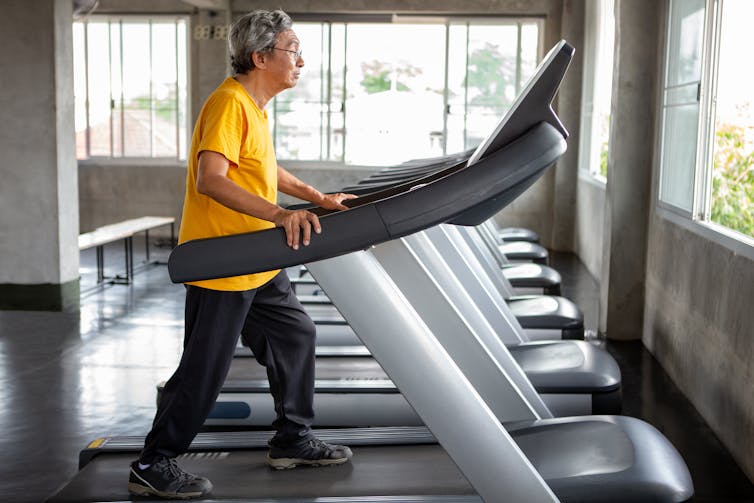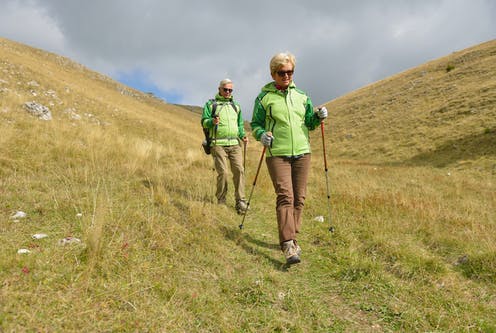Falls are a common cause of injury in older adults and can lead to disability. Luckily, the risk of falls can be reduced with regular exercise– but not all exercise. Our latest study shows that so-called eccentric exercise – such as walking downhill – may temporarily increase the risk of falling.
Every activity we do requires our muscles to either shorten or lengthen. For example, when we climb a flight of stairs or get out of a chair, our muscles contract and shorten (a concentric contraction). Our muscles also lengthen during movements – an eccentric contraction. When we walk downhill, descend stairs, or go from standing to sitting, the muscles in our thighs lengthen under the load to slow the body down, like brakes.
However, eccentric contractions can cause short-term muscle damage and sensations of muscle soreness, particularly if it’s been a while since you were last physically active.
For example, if you aren’t used to walking downhill or performing a squat, you will experience muscle soreness. This soreness may occur a few hours after exercise, and can last for several days. This pain is called “delayed onset muscle soreness”, or DOMS. Typically, exercise involving primarily concentric contractions, such as cycling, does not cause substantial DOMS.
While DOMS is perfectly normal, new evidence from our laboratory shows that eccentric exercise leads to muscle weakness and impaired physical function in older adults, which may increase the risk of falls for several days.
Eccentric exercise
In our study, we compared the effects of two types of exercise: those involving mainly concentric contractions (walking on a level surface) with exercise involving mainly eccentric contractions (downhill walking). We also looked at the effects of these types of exercise on short (30 minutes) and long-term (24 and 48 hours) recovery of muscle strength, balance and physical function in adults aged 65-78 years.
We recruited a total of 19 healthy older males and females who were not used to eccentric exercise. Ten of the participants were assigned to a level walking group, while nine were assigned to a downhill walking group. We matched participants by sex, age, physical activity levels and self-selected walking speed.
Participants attended our lab three days in a row. On the first day, we measured pre-exercise balance, muscle strength and physical functional performance. The participants then performed 30 minutes of either walking on a level treadmill or a downhill treadmill. We then measured the same outcomes immediately post-exercise, and again at 15 minutes, 30 minutes, 24- and 48-hour intervals after the initial exercise tests. All tests were undertaken at the same time of day.
As expected, we found that level walking caused a short-term increase in the risk of falling immediately after exercise. We found that 30 minutes of level walking caused a loss of balance, reduced physical function (such as being less able to stand from a chair and slower walking speed), and muscle weakness.
The increased risk of a fall immediately after concentric muscle contractions is probably because of the build-up of metabolic byproducts (such as hydrogen ions or inorganic phosphate) that reduce the muscle fibres’ ability to produce force. However, the negative effects of fatigue from this type of exercise were short lived. All participants recovered to pre-exercise levels around 30 minutes after stopping exercise.

Iammotos/ Shutterstock
In contrast, there was a delayed and prolonged increase in the risk of a fall following downhill walking. We were surprised to initially find no change in balance and physical function 30 minutes after exercise, though participants experienced muscle weakness. However, people had substantial losses of balance, physical function, and muscle weakness that occurred at least 24 hours after exercise – and remained impaired at least 48 hours after exercise.
These findings suggest that the muscle damage that happens after unaccustomed eccentric exercise leads to muscle weakness, balance problems, and impaired physical function – which can persist for several days. This could endanger an older person’s safety by increasing their risk of falling.
We don’t yet fully understand how and why eccentric contractions cause a loss of physical function that persists, but we think that it’s due to damage to certain structures in the muscle that enable movement. Inflammation inside the muscle – which takes time to develop after exercise – may also be a cause.
While regular exercise is important for good health and longevity, older adults should be mindful that exercise can temporarily increase the risk of a fall and lower physical function.
Many common daily activities, such as descending stairs or walking downhill, rely almost exclusively on eccentric muscle contractions, which means they carry a higher risk of falling. However, this isn’t a reason to lose hope. Subsequent eccentric exercise performed days, weeks, or possibly even months after an initial bout results in less muscle damage and soreness in the future. Frequently performing strength-building eccentric exercises, such as squats, are very effective in older adults and may reduce the risk of falls in the long term.
For those wanting to perform eccentric exercise to build strength and fitness, it’s important to be aware of the possible negative effects on physical function in the days after first taking up a programme.
![]()
Matt Hill receives funding from the Wellcome Trust.











